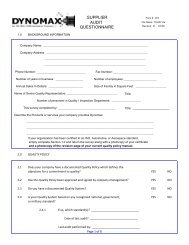Create successful ePaper yourself
Turn your PDF publications into a flip-book with our unique Google optimized e-Paper software.
When a tool collision occurs using a conventional, steep-taper shank, the potential damage can<br />
be considerably greater than when using an HSK shank. Because a CAT (SK, BT) shank is solid<br />
steel, most of the collision load (and damage) transfers to the <strong>spindle</strong>. With its hollow design,<br />
however, the HSK shank acts as a fuse during collisions. When a cutting tool crashes, the<br />
toolholder breaks off and protects the <strong>spindle</strong>, thus reducing repair costs and machine<br />
downtime.<br />
CAT (SK, BT) <strong>spindle</strong>s may be reground to restore proper performance. Although regrinding<br />
must be done by a professional, many companies offer this service. On the other hand,<br />
regrinding of an HSK <strong>spindle</strong> is considerably more difficult, requiring a highly skilled operator,<br />
an extremely precise grinding machine and the proper gauging equipment. Because this work is<br />
beyond the capabilities of many machine shops, the cost is higher than is true for regrinding<br />
steep-taper <strong>spindle</strong>s.<br />
The tool-changing capability of HSK is another improvement when compared to steep-taper<br />
shanks. Because of the short length of the HSK taper (approximately one-half the length of a CAT<br />
shank) and the lighter weight of its hollow shank, tool changes can be completed more rapidly<br />
than is true with conventional toolholders. <strong>Part</strong> of this time savings results from the fact that the<br />
HSK interface does not require a retention knob to clamp the shank.<br />
Variable cutting conditions can adversely affect the CAT (SK,BT) interface. This applies<br />
particularly to modern CNC machining centers that are used in flexible manufacturing systems.<br />
Under these circumstances, machines may operate at low speed and high torque, as well as high<br />
speed and low torque. Because conventional toolholders are clamped from the outside,<br />
centrifugal force causes the <strong>spindle</strong> walls to expand faster in relation to the shank at <strong>spindle</strong><br />
speeds higher than 8,000 rpm. Consequently, the draw bar force pulls the shank deeper into its<br />
receiver, changing the position of the tool tip and frequently locking up the tool.<br />
The HSK interface is not subject to this problem because of firm contact between mating<br />
components. This contact is enhanced at high speeds because, as the collet segments in the<br />
receiver rotate inside the hollow shank, centrifugal force increases the clamping force.<br />
Additional Performance Factors<br />
In terms of tool balancing, HSK and SK adapters are similar. HSK adapters are normally sold<br />
unbalanced but, if balancing is required, the customer should specify this when placing an order.<br />
Two methods are used to balance HSK tooling. The first method balances by using a cutting tool<br />
to remove excess material from the adapter housing. This method is recommended for heatshrink<br />
tooling, and both the tool and toolholder must be balanced (usually by the manufacturer).<br />
The second method incorporates adjustable components such as screws that allow fine-tuning of<br />
the tooling assembly prior to use. Although this method is more accurate, it also requires<br />
frequent user intervention to make balancing adjustments.<br />
Both HSK and steep taper shanks allow for use of an internal coolant supply. At <strong>spindle</strong> speeds<br />
exceeding 20,000 rpm, however, internal coolant may destroy the static balancing of the<br />
<strong>spindle</strong>/toolholder assembly. This can occur because of asymmetrical coolant channels in the<br />
tooling or by contamination with air and oil. In these cases, using external coolant may be<br />
necessary.<br />
HSK tooling is manufactured according to more rigorous specifications than steep-taper tools.<br />
One reason for tighter tolerances is because the force of the clamping mechanism improves as<br />
the clearance between toolholder and receiver is reduced. As a result of its minimal clearances,<br />
the HSK interface requires even greater attention to cleanliness of shank surfaces than is true<br />
when using conventional toolholders. HSK tools are also more sensitive to wear than other types<br />
- 36 -



